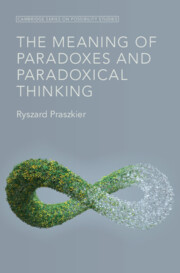Book contents
- The Meaning of Paradoxes and Paradoxical Thinking
- Cambridge series on possibility studies
- The Meaning of Paradoxes and Paradoxical Thinking
- Copyright page
- Contents
- Figures
- Tables
- Acknowledgments
- Introduction
- Part 1 Paradoxes and What They Do to Us
- Part II Sudden Unexpected Changes
- Part III Challenging the Impossible
- Part IV Peace and Its Challenges
- Part V Paradoxes and Creativity
- Introduction
- Chapter 12 Generating New and Useful Ideas
- Chapter 13 Brain Plasticity
- Chapter 14 Avenues for Enhancing Neuroplasticity
- Discussion and Summary
- Part VI Paradoxes in Action
- References
- Index
Chapter 13 - Brain Plasticity
from Part V - Paradoxes and Creativity
Published online by Cambridge University Press: 04 April 2025
- The Meaning of Paradoxes and Paradoxical Thinking
- Cambridge series on possibility studies
- The Meaning of Paradoxes and Paradoxical Thinking
- Copyright page
- Contents
- Figures
- Tables
- Acknowledgments
- Introduction
- Part 1 Paradoxes and What They Do to Us
- Part II Sudden Unexpected Changes
- Part III Challenging the Impossible
- Part IV Peace and Its Challenges
- Part V Paradoxes and Creativity
- Introduction
- Chapter 12 Generating New and Useful Ideas
- Chapter 13 Brain Plasticity
- Chapter 14 Avenues for Enhancing Neuroplasticity
- Discussion and Summary
- Part VI Paradoxes in Action
- References
- Index
Summary
Fifty years ago, the predominant conviction was that the adult brain is fixed and unchangeable. In contrast, the new concept views that the brain can adjust and modify itself. Harnessing the brain’s ability to create and open new neuronal pathways often plays a key role in rehabilitation and improvement of life quality. Healthy brain neuroplasticity may be augmented. Synaptic plasticity is defined as forming new neural paths and connections, whereas neurogenesis indicates that stem cells can reproduce fully functioning brain cells. Synaptic brain plasticity refers to changes in neural pathways and synapses that are due to alternations in behavior, environment, and neural processes, and is one of the important neurochemical foundations of learning and memory. Neurotransmitters convey a message from one neuron to another. One such neurotransmitter is dopamine, initiating further motivated behavior. Endorphins serve as a brain-controlled painkiller, also delivering feelings of pleasure and euphoria. Serotonin is best known for its role in conveying a sense of contentedness. Neurotransmitters also create feelings of pleasure. Neurogenesis is the process by which neurons are produced by the brain’s stem cells. It is most active during embryonic development and is responsible for producing all of the various types of neurons in an organism, but also continues throughout adult life
Keywords
- Type
- Chapter
- Information
- The Meaning of Paradoxes and Paradoxical Thinking , pp. 101 - 106Publisher: Cambridge University PressPrint publication year: 2025

